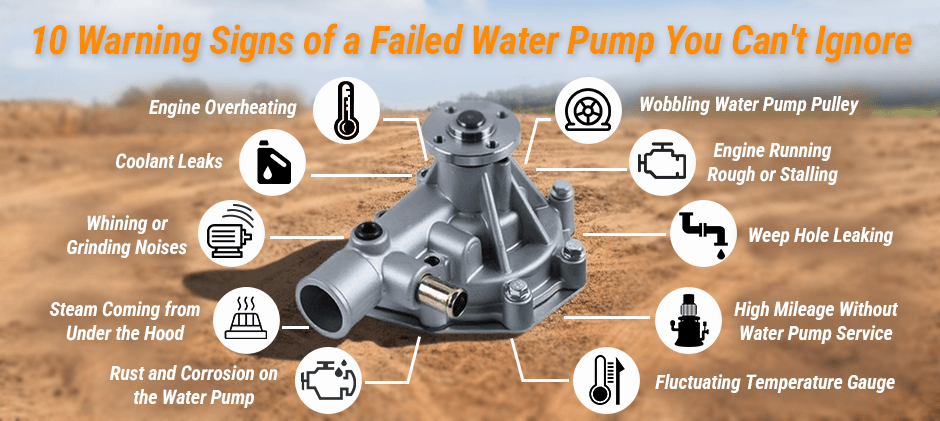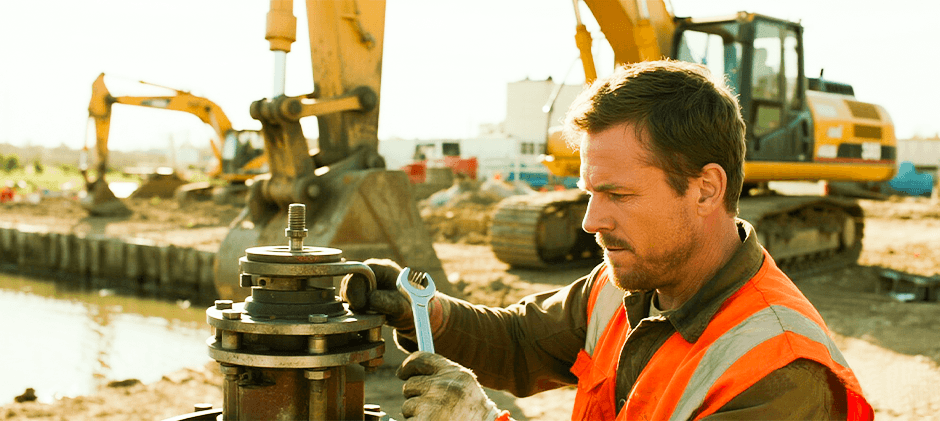Your engine’s water pump might be small, but it’s mighty important. Think of it as your engine’s heart – it keeps coolant flowing through your system, preventing your engine from turning into an expensive paperweight. When your water pump starts failing, you need to act fast. Let’s dive into the telltale signs that your water pump needs attention and what you can do about it.
What Does a Water Pump Do?
Before we jump into the warning signs, let’s quickly cover what your water pump actually does. Your water pump pushes coolant from the radiator through your engine block and back again. This continuous flow keeps your engine at the right temperature – not too hot, not too cold. Without it, your engine would overheat faster than you can say “roadside breakdown.”
At FridayParts, we’ve seen countless engines saved by catching water pump problems early. That’s why we’re sharing these signs with you – so you can spot trouble before it leaves you stranded.
10 Warning Signs of a Failed Water Pump
Below are 10 reasons to replace your water pump based on our customer feedback and the most common water pump problem warnings.
1. Engine Overheating
When your temperature gauge starts climbing into the red zone, your water pump might be the culprit. A failing water pump can’t circulate coolant properly, which means your engine heats up like a stovetop. You might notice the temperature climbing during idle or when you’re stuck in traffic.
What to do: Pull over safely and let your engine cool down completely (this takes at least 30 minutes). Check your coolant level once the engine is cool. If it’s low, top it off and monitor the temperature closely. If overheating continues, don’t risk driving – get your water pump checked immediately.
Remember, driving with an overheating engine is like playing with fire – literally. One overheated trip could warp your cylinder head or blow a head gasket, turning a $200 water pump replacement into a $2,000 repair bill.
2. Coolant Leaks Under Your Vehicle
Ever notice a puddle of green, orange, or pink fluid under your car? That’s probably coolant, and it might be coming from your water pump. Water pumps have seals and gaskets that wear out over time, creating leaks. The leak usually shows up right under the water pump location, which is typically at the front of your engine.
You might spot dried coolant residue around the pump area, too – it looks like colored chalk or crystals. This happens when small amounts of coolant leak out and evaporate, leaving behind the additives.
Quick tip: Place a piece of cardboard under your engine overnight. In the morning, you’ll see exactly where any leaks are coming from. Fresh coolant feels slippery between your fingers and has a sweet smell (but don’t taste it – it’s toxic!).
3. Whining or Grinding Noises from the Engine
Your water pump shouldn’t make noise. When you hear whining, grinding, or growling sounds coming from the front of your engine, your water pump bearings might be worn out. The noise usually gets louder when you rev the engine because the pump spins faster.
These sounds happen because the pump’s internal bearings are failing. As they wear down, metal grinds against metal, creating that awful noise. Sometimes you’ll hear a high-pitched whine that changes with engine speed – that’s your water pump crying for help.
How to check: With the engine running (and cool), use a mechanic’s stethoscope or a long screwdriver as a listening device. Place one end on the water pump housing and listen. A healthy pump sounds smooth and quiet. A failing pump sounds rough, like marbles in a can.
4. Steam Coming from Under the Hood
Seeing steam billowing from under your hood is scary – and for good reason. When coolant hits hot engine parts, it instantly turns to steam. This usually means your water pump has failed completely or you’ve got a major coolant leak.
The steam might come with a sweet smell (that’s the coolant), and you’ll probably see your temperature gauge maxed out. This is an emergency situation – continuing to drive could destroy your engine in minutes.
What to do right now: Turn off your engine immediately and get to safety. Don’t open the hood right away – wait for the steam to stop and the engine to cool. Call for a tow truck. This isn’t something you can fix on the roadside, and driving even a short distance could cause catastrophic damage.
5. Rust and Corrosion on the Water Pump
Take a look at your water pump during your next oil change. See any orange or brown buildup around it? That’s rust and corrosion, often caused by using the wrong coolant or not changing it regularly. This gunk can eat away at your pump’s seals and housing.
Corrosion happens when air gets into your cooling system or when coolant breaks down over time. Old coolant loses its rust-inhibiting properties, letting corrosion attack your water pump from the inside out. You might also see small holes (pitting) in the pump housing – these are signs of advanced corrosion.
At FridayParts, we recommend using the coolant type specified in your owner’s manual and changing it every 30,000 miles or two years. Mixing different coolant types can cause chemical reactions that accelerate corrosion.
6. Wobbling Water Pump Pulley
Your water pump pulley should spin smoothly without any wobble or play. When the pump’s bearings wear out, the pulley starts to wobble like a wobbly table. You can check this with the engine off – grab the pulley and try to wiggle it. Any movement means trouble.
A wobbling pulley puts extra stress on your drive belt and can cause it to wear unevenly or come off completely. You might notice your belt squealing or see black rubber dust around the pulleys – these are signs of a misaligned or wobbling water pump pulley.
Safety first: Always check with the engine off and cool. A spinning pulley or belt can cause serious injury. If you’re not comfortable doing this check yourself, ask your mechanic to look during your next service.
7. Engine Running Rough or Stalling
When your water pump fails, your engine might run rough or stall unexpectedly. This happens because modern engines have temperature sensors that detect overheating. When these sensors notice high temperatures, they can trigger “limp mode” or shut down the engine to prevent damage.
You might experience rough idling, misfires, or sudden power loss. Your check engine light might come on, too. These symptoms can feel random, but they often happen when your engine gets too hot from poor coolant circulation.
Don’t ignore these warning signs. Your engine’s computer is trying to protect itself from expensive damage. Get your cooling system checked before a small problem becomes a big one.
8. Weep Hole Leaking
Here’s something many drivers don’t know – water pumps have a built-in warning system called a weep hole. This small hole is designed to leak when the pump’s internal seals start failing. It’s actually doing you a favor by warning you before complete failure.
Look for a small hole on the underside of your water pump. If you see coolant dripping or dried coolant residue around this hole, your pump’s seals are going bad. This is your early warning system – don’t ignore it!
The weep hole prevents coolant from getting into the bearing assembly, which would cause rapid failure. When you see leaking here, you typically have some time before complete failure, but don’t push your luck. Plan for a new replacement soon.
9. High Mileage Without Water Pump Service
Water pumps don’t last forever. Most need replacement between 60,000 and 90,000 miles, though some can last longer. If you’re pushing past 100,000 miles on your original one, you’re living on borrowed time.
Here’s why mileage matters: Water pump seals and bearings wear down gradually. By the time you hit high mileage, these parts are tired. The pump might still work, but it’s not pumping as efficiently as it should. This puts extra stress on your entire cooling system.
Check your service records. If your water pump hasn’t been replaced and you’re over 80,000 miles, consider having it inspected. Preventive replacement during a timing belt service (on engines where they’re connected) can save you money and headaches down the road.
Many mechanics recommend replacing the water pump when doing a timing belt service, since they’re already in there. It’s like replacing the batteries in your smoke detector – better safe than sorry.
10. Fluctuating Temperature Gauge
Does your temperature gauge dance up and down like it can’t make up its mind? This could signal water pump problems. A failing pump can’t maintain steady coolant flow, causing temperature spikes and drops.
You might notice the gauge climbing during acceleration and dropping at idle, or random fluctuations that don’t match your driving. This happens because the pump impeller (the part that moves the coolant) might be damaged or loose on the shaft.
Don’t confuse this with normal behavior: Some temperature fluctuation is normal, especially in stop-and-go traffic. But if your gauge swings wildly or quickly, that’s not normal. A properly working cooling system keeps temperatures steady within a narrow range.
How to Fix Water Pump Problems
Now that you know the warning signs, let’s talk solutions. Water pump problems usually have one fix: replacement. Here’s what you need to know:
- DIY or Professional: Replacing a new pump ranges from moderately difficult to extremely challenging, depending on your vehicle. Some pumps are easily accessible, while others require removing multiple components. If you’re handy with tools and have a good repair manual, you might tackle it yourself. Otherwise, trust a professional.
- Cost Considerations: A water pump itself costs between $50−$200 at FridayParts, depending on your vehicle. While this might seem expensive, remember that engine damage from overheating can cost thousands.
- What Gets Replaced: When replacing your pump, also replace the thermostat, radiator cap, and coolant. These are cheap parts that work together with your water pump. It’s false economy to skip them. Many mechanics also recommend replacing drive belts and coolant hoses if they’re showing age.
Preventing Water Pump Failure
The best fix is prevention. Here’s how to keep it happy:
- Use the Right Coolant: Different engines need different coolant types. Using the wrong one can cause corrosion and premature pump failure. Check your owner’s manual and stick with what’s recommended.
- Change Coolant Regularly: Old coolant loses its protective properties. Change it every 30,000 miles or as recommended. This simple maintenance can double your water pump’s life.
- Fix Leaks Promptly: Running low on coolant makes your pump work harder and run hotter. Fix any leaks quickly to prevent damage.
Listen to Your Engine: Strange noises don’t fix themselves. If you hear whining or grinding, investigate promptly.
Conclusion
Your water pump works hard every time you drive, keeping your engine at the perfect temperature. When it starts failing, these 10 signs will warn you – but only if you’re paying attention. Don’t ignore them.
At FridayParts, we’ve seen too many engines ruined by ignoring these problems. The good news? Catching these signs early usually means a simple repair instead of a new engine. Stay alert, maintain your cooling system, and your water pump will keep your engine running cool for miles to come.
Remember, when in doubt, have it checked out. A few minutes with a mechanic could save you thousands in repairs and keep you safely on the road.


